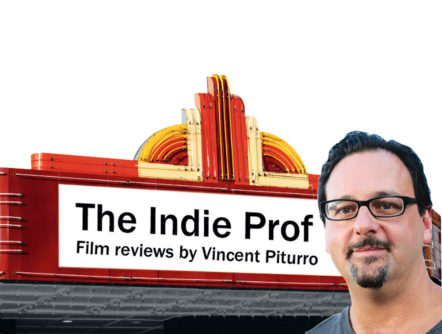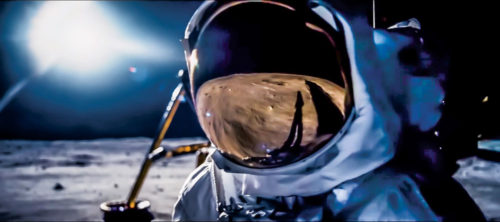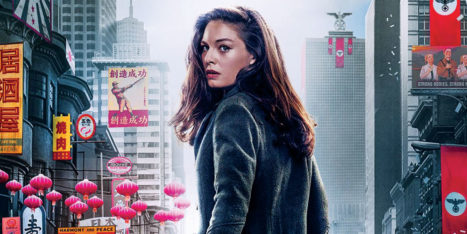
Each month, the Indie Prof reviews a current film in the theater and second film or series available on DVD or instant-streaming service. Follow “Indie Prof” on Facebook for updates about film events and more reviews.
First Man (2018)

First Man
This wonderful film is the latest effort from Damien Chazelle, whose last film was the widely acclaimed La La Land (2016). Here, he teams with the same cinematographer (Linus Sandgren), the same editor (Tom Cross), and the same star (Ryan Gosling) to tell the story of Neil Armstrong and the moon landing of the Apollo 11 mission. After the highly stylized theatrics of La La Land, everyone was expecting similar treatment of this material; what we got was quite different, extremely personal, and intensely real. After La La Land and his film previous to that, Whiplash (2014), Chazelle has established himself as one of the finest directors of a generation.
The shot of choice in the film is the close-up: we get close to the characters early on and stay there, probing Gosling’s face and trying to find the emotion that we are all projecting onto him. Does he think about his daughter’s death at all? Too much? Is he ebullient at being named to lead the mission and the first person to walk on the moon? While the film gives us clues to his emotions through flashbacks and one moving scene on the moon (he releases his daughter’s bracelet into a crater) we never know for sure. We do know for sure about Janet Armstrong, as Claire Foy gives an Oscar-worthy performance. Fiery and energetic, she is the emotion to Gosling’s earnestness. It is a brilliant and inspired pairing.
The film is not without controversy, however. President Trump has criticized it for not showing the American flag actually being planted on the moon (it is clearly visible in a shot, however), and some have criticized the scene on the moon where Armstrong tears up as he thinks about his daughter. Most biographers and others who knew Armstrong at the time said he did not bring his daughter’s bracelet with him. To both I say: who cares?
Chazelle took pains to make the film as scientifically accurate as possible—it has been praised for showing exactly how the flights took place, right down to the placement of the knobs. The film is not meant to be a flag-waving, overly patriotic tome: it is the story about a quiet man thrust into heroic acts (a very universal story). As far as his daughter’s bracelet, I took it as symbolic and expressionistic. It spoke to how he may have felt at the time. And oh yeah, it is not a documentary. It is a film with heart, decency, and honesty. That is good enough for me.
You will like this film if you enjoyed Moonlight, 12 Years a Slave, and/or Manchester by the Sea.
Now playing at theaters all over.
The Man in the High Castle

Man in the High Castle
Season 3 (Amazon)
I have previously reviewed season 1 (December 2015), and season 2 followed in December 2016. In my review of season 1, I stated “It is an ambitious project, and it works.” I also said it was a slow-moving plot with a plethora of characters, and therefore it could be hard to follow.
Season 2 was not much different, but season 3 triples down.
The first two seasons followed the crux of Dick’s book: an alternative ending to WWII leaves the Nazis in charge of the U.S. east coast while the Japanese rule the west coast. The man in the high castle, however, a mythical figure in the middle of the country’s free zone, holds a warehouse full of films that tell a different story—the actual ending of the war where the Allies defeated the Axis powers. The central question of the first two seasons is simple: where do the films come from? Season 3 goes beyond.
We get the same characters in season 3, we add in a few more, and we lose a few along the way. The main characters remain the resistance fighter Juliana Crane (a dour Alexa Davalos), Nazi commander John Smith (an excellent Rufus Sewell), and Japanese Trade Minister Tagomi (Cary Hiroyuki-Tagawa in an understated performance). Much of the show’s creative team remains intact, and the atmosphere they realize is the actual star of the show: the bright lights of the Nazi machine in NYC, the gray and shadowy tones of Japanese San Francisco, and the sepia-infused uneasiness of the free zone. Each location hits just the right notes and captures the essence of the milieu and emotions of the characters.
Yes, the show can be hard to follow. Yes, it gets heady at times. Yes, it is tightly wound. And yes, it moves deep into sci-fi in season 3. But it is also spot-on in its execution, extremely tight in its character studies, and exacting in every minute detail of the aesthetic. If you haven’t seen the first two seasons, you should certainly do so before moving on to season 3. Find out what’s on the other side.
You will like this show if you enjoyed The Handmaid’s Tale, Blade Runner 2049, and/or Black Mirror.
Now available on Amazon Prime.
Vincent Piturro, Ph.D., is an associate professor of Cinema Studies at Metropolitan State University of Denver. He can be reached at vpiturro@msudenver.edu.



0 Comments